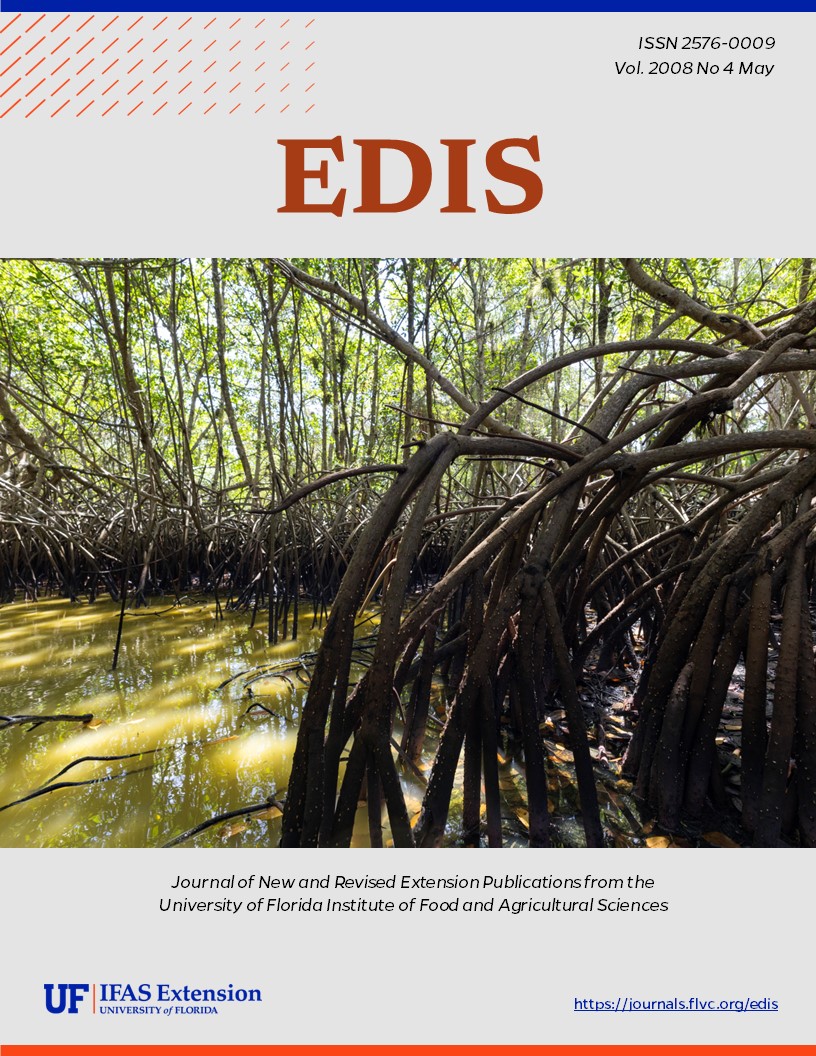Abstract
AN199, a 6-page fact sheet bu Tyrell Kahan, Sally Williams, Ray Mobley, Ikechukwu Ezenwa, and Eric Peterson, describes the use of tanniferous plants to control internal parasites in meat goats. Includes references. Published by the UF Department of Animal Science, March 2008.
References
Adejumo, J. O. and A. A. Ademosun. 1991. Utilization of leucena as supplement for growing dwarf sheep and goats in the humid zone of West Africa. Small Rumin. Res. 5:75-82. https://doi.org/10.1016/0921-4488(91)90032-L
Akhtar, M. S. and I. Ahmad. 1992. Comparative efficacy of Mallotus philippinensis fruit (Kamala) or Nilzan drug against gastrointestinal cestodes in Beetal goats. Small Rumin. Res. 8:121-128.
https://doi.org/10.1016/0921-4488(92)90013-T
Ashraf, M. and K. H. Nepote. 1990. Prevalence of gastrointestinal nematodes, coccidian and lungworms in Maryland dairy goats. Small Rumin. Res. 3:291-298. https://doi.org/10.1016/0921-4488(90)90046-9
Bahuaud, D., C. Martinez-Ortiz De Montellano, S. Chauveau, F. Prevot, F. Torres-Acosta, I. Fouraste and H. Hoste. 2005. Effects of four tanniferous plant extracts on the in vitro exsheathment of third-stage larvae of parasitic nematodes. Parasitology. http://orgprints.org/6980/, Accessed 01-31-2008.
Bhatta, R., A. K. Shinde, D. L. Verma, S. K. Sankhyan and S. Vaithiyanathan. 2004. Effect of supplementation containing polyethylene glycol (PEG)-6000 on intake, rumen fermentation pattern and growth in kids fed foliage of Prosopis cineraria. Small Rumin. Res. 52:45-52. https://doi.org/10.1016/S0921-4488(03)00222-0
Chandrawanthani, P., N. Yusoff, L. C. Wan, A. Ham and P. J. Waller. 2004. Total anthelmintic failure to control nematode parasites of small ruminants on government breeding farms in Sabah, East Malaysia. Vet. Res. Commun. 28:479-489. https://doi.org/10.1023/B:VERC.0000040240.69004.dc
Food and Agriculture Organization. 2003. Goat: population. Regional Office for Asia and the Pacific. Available at: http://www.fao.org/docrep/004/ad452e/ad452e2z.htm. Accessed May 2007.
Gaskin, J. M. 2006. Mastering the McMasters method of fecal helminth egg count quantification. Presented at the Florida Goat Assoc. annu. conf., Gainesville, FL.
Hale, M. 2006. Managing Internal Parasites in Sheep and Goats. ATTRA. Retrieved January 19, 2007 from http://attra.ncat.org/attra-pub/PDF/parasitesheep.pdf
Hoste, H., L. Gaillard and Y. Le Frileux. 2005. Consequences of the regular distribution of sainfoin hay on gastrointestinal parasitism with nematodes and milk production in dairy goats. Small Rumin. Res. 59:265-271. https://doi.org/10.1016/j.smallrumres.2005.05.011
James, N. A., B. W. Berry. 1997. Use of chevon in the development of low-fat meat products. J. Anim. Sci. 75:571-577. https://doi.org/10.2527/1997.752571x
Ketzis, J. K., J. Vercruysse, B. E. Stromberg, M. Larsen, S. Athanasiadou, and J. G. M. Houdijk, 2006. Evaluation of efficacy expectations for novel and non-chemical helminth control strategies in ruminants. Veterinary Parasitology. 139:321-335. https://doi.org/10.1016/j.vetpar.2006.04.022
Lange, K. C., D. D. Olcott, J. E. Miller, J. A. Mosjidis, T. H. Terrill, J. M. Burke, and M. T. Kearney. 2006. Effect of Sericea lespedeza (Lespedeza cuneata) fed as hay, on natural and experimental Haemonchus contortus infections in lambs. Veterinary Parasitology. Article in Press. https://doi.org/10.1016/j.vetpar.2006.06.001
Luginbuhl, J. M. 2002. Gastrointestinal parasite management of meat goats. Available: http://www.cals.ncsu.edu/an_sci/extension/animal/meatgoat/MGWormer.htm. Accessed May 4, 2006.
McMillin, K. W. and A. P. Brock. 2005. Production practices and processing for value-added goat meat. J. Anim. Sci. 83:E57-E68.
Min, B. R. and S. P. Hart. 2003. Tannins for suppression of internal parasites. J. Anim. Sci. 81:E102-E109.
Min, B. R., W. E. Pomroy, S. P. Hart, and T. Sahlu. 2004. The effect of short-term consumption of a forage containing condensed tannins on gastro-intestinal nematode parasite infections in grazing wether goats. Sma. Rumin. Res. 51:279-283. https://doi.org/10.1016/S0921-4488(03)00204-9
Min, B. R., S. P. Hart, D. Miller, G. M. Tomita, E. Loetz and T. Sahlu. 2005. The effect of grazing forage containing condensed tannins on gastro-intestinal parasite infection and milk composition in Angora does. Veterinary Parasitology. 130:105-113. https://doi.org/10.1016/j.vetpar.2005.03.011
Niezen, J. H., W. A. G. Charleston, J. Hodgson, A. D. Mackay and D. M. Leathwick. 1998. Controlling internal parasites in grazing ruminants with recourse to anthelmintics: Approaches, experiences, and prospects. International Journal of Parasitology. 26:983-992. https://doi.org/10.1016/S0020-7519(96)80076-2
Nguyen, T. M., D. V. Binh and E. R. Orskov. 2005. Effect of foliages containing condensed tannins and on gastrointestinal parasites. Ani. Feed Sci. Technol. 121:77-87. https://doi.org/10.1016/j.anifeedsci.2005.02.013
Paolini, V., F. De La Farge, F. Prevot, Ph. Dorchie and H. Hoste. 2005a. Effects of the repeated distribution of sainfoin hay on the resistance and the resilience of goats naturally infected with gastrointestinal nematodes. Veterinary Parasitology. 127:277-283. https://doi.org/10.1016/j.vetpar.2004.10.015
Paolini, V., F. Prevot, Ph. Dorchies and H. Hoste. 2005b. Lack of effects of quebracho and sainfoin hay on incoming third-stage larvae of Haemonchus contortus in goats. Vet. J. 170:260-263. https://doi.org/10.1016/j.tvjl.2004.05.001
Paolini, V., I. Fouraste and H. Hoste. 2004. In vitro effects of three woody plants and sainfoin extracts on 3rd-stage larvae and adult worms of three gastrointestinal nematodes. Parasitology. 129:69-77. https://doi.org/10.1017/S0031182004005268
Scogings, P. F., L. E. Dziba and I. J. Gordon. 2004. Leaf chemistry of woody plants in relation to season, canopy retention and goat browsing in a semiarid subtropical savanna. Austral Ecology. 29:278-286. https://doi.org/10.1111/j.1442-9993.2004.01347.x
Semenye, P. P. 1990. Toxicity response of goats fed on Leucena leucocephala forage only. Small Rumin. Res. 3:617-620. https://doi.org/10.1016/0921-4488(90)90056-C
Shaik, S.A. Terrill, T.H. Miller, J.E. Kouakou, B. Kannan, G. Kaplan, R.M., Burke, J.M. and Mosjidis, J.A. 2006. Sericea lespedeza hay as a natural deworming agent against gastrointestinal nematode infection in goats. Veterinary Parasitology. 139:150-157. https://doi.org/10.1016/j.vetpar.2006.02.020
USDA National Agricultural Statistics Service. 2007. Sheep and Goats. Available at: http://usda.mannlib.cornell.edu/usda/current/SheeGoat/SheeGoat-02-01-2008.txt. Accessed May 2007.
Waller, P.J. 2004. Management and control of nematode parasites of small ruminants in the face of total anthelmintic failure. Tropical Biomedicine 21:7-13.
Waller, P. J. and S. M. Thramsborg. 2004. Nematode control in green ruminant production systems. Trends in Parasitology. 20 (10): 493-497. https://doi.org/10.1016/j.pt.2004.07.012

